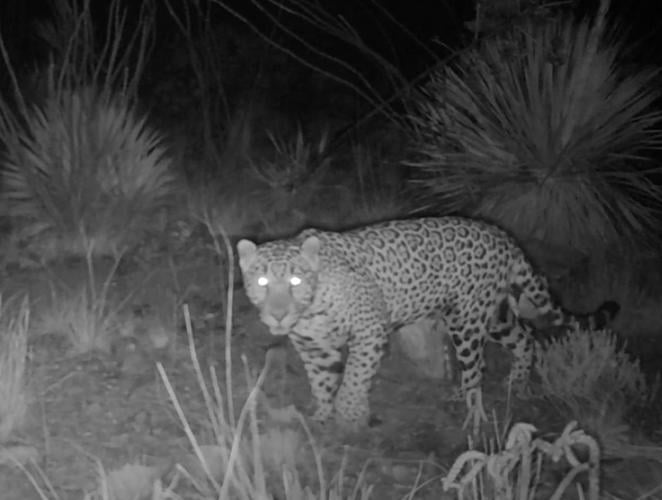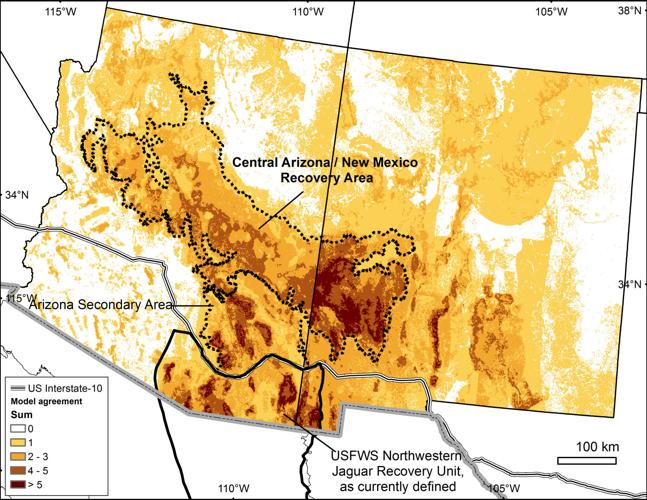A group of scientists is making a case for the reintroduction of jaguars across a wide swath of Arizona and New Mexico, from the White Mountains to as far north as Flagstaff and as far west as Prescott.
In a paper published Tuesday in the journal Conservation Science and Practice, 16 conservation biologists argue that restoring the endangered cat to more of its historic range would “remedy the injustice” of the animals being wiped out by humans almost 60 years ago.
“This is a special place where jaguars used to be and should be again,” said Eric Sanderson, lead author of the paper. “From a conservation perspective, this makes sense, so let’s have a conversation about it.”
As the paper puts it: “Our world’s natural heritage is diminished nearly everywhere; here is a model for who, where, how and why people should invest in restoring it. For the jaguar, America’s Great Cat, the question is when.”
Ultimately, the group hopes to convince the U.S. Fish and Wildlife Service to revisit its 2018 recovery plan for the jaguar, which identified the area south of Interstate 10 in Southern Arizona and New Mexico as the only U.S. habitat for the species.
According to the service, that land is only capable of supporting about six jaguars.
The cat is listed as endangered on both sides of the border. In the U.S., just seven adult males have been photographed in the wild since 1996. No female jaguars have been seen since 1963, when an Arizona hunter killed one near Big Lake in the White Mountains.
The new paper builds on a study released earlier this year by many of the same scientists that identified roughly 2 million acres in two states as potentially suitable habitat for up to 150 jaguars.
“If they have cover, a little bit of water and prey — and humans aren’t harassing them — they do fine,” Sanderson said.
But while there is a strong ecological case to be made for bringing the big cats back, there are potential conflicts to consider. The authors acknowledge that jaguars will undoubtedly prey on livestock in the area, though they predict minimal losses that can be reduced further with range management techniques and offset by compensation payments.
As for human safety, the paper notes that more than 370,000 people live within the proposed release area, but unprovoked attacks by jaguars are extremely rare throughout the Americas. None have been recorded in the U.S. in the 21st century, the paper says, “despite near continuous occupation by the species, albeit at very low densities, including near populated areas such as Tucson.”
The authors stressed that any reintroduction would require the full cooperation of federal, state and tribal officials and consultation with the public, particularly those living in and around release areas.
Similar efforts to reestablish the Mexican gray wolf in some of the same parts of Arizona and New Mexico have sparked controversy, particularly among ranchers.
But such wildlife reintroductions there and elsewhere have also proven popular, even profitable as a tourist draw for some communities.
Sanderson said there’s no way to know how local residents might feel about the reintroduction of the jaguar until you ask them. The approach to conservation has changed a lot since jaguars last roamed the White Mountains, and so have people’s attitudes about sharing their landscape with wild animals — even potentially dangerous ones.
“Just because people 50 years ago thought it was a good idea to hunt out jaguars and hunt out wolves, that doesn’t mean we have to stick with those decisions,” Sanderson said.
He added that a future study, due sometime next year, will examine how a jaguar reintroduction might actually be done, including where the source animals might come from.
One of the paper’s co-authors, Michael Robinson, is a senior conservation advocate for the Tucson-based Center for Biological Diversity. His home north of Silver City, New Mexico, is within walking distance of the Gila Wilderness, one of the places identified for possible jaguar reintroduction.
He said federal wildlife officials seem content to wait for the jaguar population in northern Mexico to decline and for the few jaguars left in the U.S. to disappear so they can remove the cat from the endangered species list once and for all.
What he and the other authors of the paper want instead is an active effort to truly recover the species to a region that “aches for its return,” he said.
“This is perhaps the only place left in the U.S. that could support a viable jaguar population,” Robinson said. “This is a chance to bring back this beautiful animal.”
This video of a female jaguar and her cub, Angel, was shot last October (2020). At the time the video was shot, Angel was about five months old. The video was shot on the Tucson-based Northern Jaguar Project’s Northern Jaguar Reserve, in rugged, mountainous terrain lying more than 100 miles south of the US-Mexican border in Sonora. Video courtesy of the Northern Jaguar Project.
Photos: Meet Reid Park Zoo's new jaguar Bella
Meet Reid Park Zoo's new jaguar Bella
Updated
Bella, a 10-year-old jaguar from Akron Zoo in Ohio, is the newest addition to Tucson's Reid Park Zoo.
Meet Reid Park Zoo's new jaguar Bella
Updated
Bella, a 10-year-old jaguar from Akron Zoo in Ohio, is the newest addition to Tucson's Reid Park Zoo.
Meet Reid Park Zoo's new jaguar Bella
Updated
Bella, a 10-year-old jaguar from Akron Zoo in Ohio, is the newest addition to Tucson's Reid Park Zoo.
Meet Reid Park Zoo's new jaguar Bella
Updated
Bella, a 10-year-old jaguar from Akron Zoo in Ohio, is the newest addition to Tucson's Reid Park Zoo.
Meet Reid Park Zoo's new jaguar Bella
Updated
Bella, a 10-year-old jaguar from Akron Zoo in Ohio, is the newest addition to Tucson's Reid Park Zoo.
Meet Reid Park Zoo's new jaguar Bella
Updated
Bella, a 10-year-old jaguar from Akron Zoo in Ohio, is the newest addition to Tucson's Reid Park Zoo.
Meet Reid Park Zoo's new jaguar Bella
Updated
Bella, a 10-year-old jaguar from Akron Zoo in Ohio, is the newest addition to Tucson's Reid Park Zoo.
Meet Reid Park Zoo's new jaguar Bella
Updated
Bella, a 10-year-old jaguar from Akron Zoo in Ohio, is the newest addition to Tucson's Reid Park Zoo.





